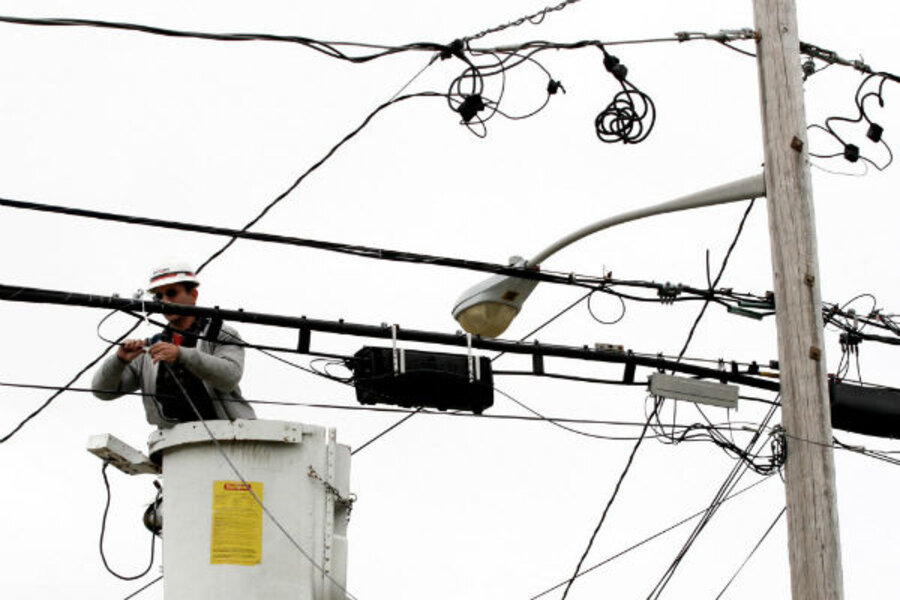Got broadband? Access now extends to 94 percent of Americans.
Access to the Internet via broadband has now spread to 94 percent of Americans, a jump of two percentage points over last year and a huge leap from the 15 percent who had such access just a decade ago.
The steady expansion of the broadband Internet infrastructure has come about as a result of both government backing and private investment, according to the Broadband Progress Report by the Federal Communications Commission (FCC) released Aug. 21. Broadband encompasses various technologies – cable, DSL, fiber optic cables – that allow people to connect to the Internet at higher speeds and download data at faster rates.
The FCC annual report commended private-sector companies for continuing to expand into ever-more remote areas, even during the recent years when the economy has struggled.
Of course, that still leaves 6 percent of the populace – some 19 million people – without a way to order from amazon.com, share photos on Facebook, or learn about job opportunities in far-away places.
Access to the Internet is essential in today's increasingly networked economy and culture, says Lee Rainie, director of the Pew Internet and American Life Project, an independent research organization that has tracked the social impact of the Internet for the past 12 years.
“People use the Internet to access alternative business options and to become more informed consumers,” says Mr. Rainie, author of “Networked: The New Social Operating System.” “People get high-quality health information so they can take care of themselves in better and smarter ways.”
The 19 million who have no broadband access includes one-fourth of people living in rural counties and one-third of people living on tribal lands, areas where infrastructure is often nonexistent. That's 7 million fewer than last year.
Closing the “last mile” of connectivity – the end of the line where the Internet is physically impossible to access due to lack of infrastructure – is expensive, and there is little financial incentive for telecommunication companies to do it.
But the 1996 Telecommunications Act requires that the federal government deploy advanced telecommunication capabilities to “all Americans in a reasonable and timely fashion.” The FCC report, for the past three years, has determined that the rate of connecting Americans to the Internet has not been fast enough.
"This year’s Report reflects the huge strides that both the private and public sector have made to extend broadband, while also explaining that there’s more work to do,” said FCC Chairman Julius Genachowski, in a statement. "Increasing broadband deployment, increasing adoption, increasing speeds and capacity are vital throughout our country; they’re essential to growing our innovation economy and driving our global competitiveness."
Two of the five commissioners disagree with the report's assessment, saying that it understates the growth.
“In reality, the growth of broadband deployment in America, especially regarding the mobile marketplace, has been swift and strong,” said Commissioner Robert McDowell, in his statement. Back in 2003, he said, only 15 percent of Americans could access broadband Internet.
Not only do more Americans than ever have access to broadband services, but more are actually taking advantage of it by subscribing to a service in the home. Sixty-four percent of those with access opted to pay for a service in 2011, compared with 62 percent in 2010, the FCC report found.
Broadband subscriptions have increased steadily over the past decade, according to data from the International Telecommunications Union, from 7 million in 2000 to 90 million in 2011 in the US. The Pew Internet project research also finds that household adoption rates in the US have increased during the past several years, although it notes that barriers remain such as affordability or simply the perception that Internet access isn't necessary.
Gaps in adoption rates are most notable among income levels, education, and race, with 70 percent of whites subscribing to broadband in the home compared with 54 percent of blacks and 51 percent of Hispanics, according to Pew Internet data.
With the advances in mobile and wireless technology, Rainie says that being connected to the Internet has become the norm for most Americans. “People aren’t differentiating between what is virtual life and real life,” he says. “Connectivity is embedded into life, its rhythms, and people’s expectations.”






